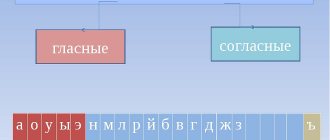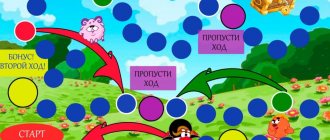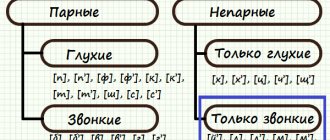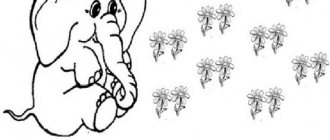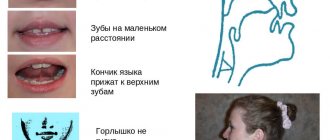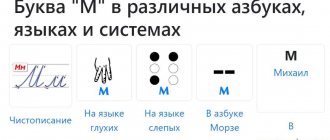LiveInternetLiveInternet
Publisher: Gnome and D
Year of publication: 2005
Russian language
Age: 5-7 years
This manual is addressed to speech therapists, teachers of speech therapy groups, and parents. Its main task is to help the child learn the correct pronunciation of the sounds P, Pь, B, B.
The manual offers practical material on production, automation and differentiation of these sounds. The manual contains a variety of lexical material, descriptions of games and individual exercises.
Examples from the book by Egorov O.V. “Sounds P, Pь, B, B. Speech material and games on automation and differentiation of sounds for children 5-7 years old"
Practical material on audio automation B
- Repeat the syllables.
Ba - ba - ba Ba - bo - bu - would
Boo-bu-bu Bo-ba-bu-would
Would - would - would Boo - bo - would - ba
Bo - bo - bo Would - boo - bo - ba
- Repeat the words.
Sound at the beginning of a word:
Buck, ball, button accordion, bathhouse, bow, base, banana, loaf, bank, bashdya, luggage, ballet, balyk, balance, hook, ram, bazaar, badger; side, bob, boots, pain, boots, boron, Borya, beard; riot, beads, storm, bouquet, paper, letter, booth, bun, mound, alarm clock; bull, life, was, byle, epic, bull.
Sound in the middle of the word: Lyuba, fur coat, toad, fish, boar, dog, estate, wedding, shirt, plane, request; lips, teeth; trunk, album, sable, bus, care, fence, work; ABC.
Confluence of consonant sounds in syllables and words:
Bvo, bwi, bni, bdu, bde, bgo; blah, blah, blah, blah, blah; bra, bra, bro, bra, bri.
Circle, encircle, embrace, embrace, consider, deprive, overtake; blank, roach, bliss; block, blockade, notepad, blond, cover; get lost, wander; glare, pancakes, dish, saucer; bra, brother, bravo, back, breaststroke, zebra, brother; break, kick; ford, armor, eyebrows, brooch; rattle, razor, apricot.
- Repeat the sentences.
Lyuba has a beautiful fur coat. Lyuba has a big bow. An elephant has a long trunk. Bori's teeth hurt. Lyuba eats bananas. My brother has a notebook. Brother shaves with a razor. Katya was very happy with the brooch. The pancakes were on a plate. There was a brooch hanging from her blouse. Lyuba is wearing beads. Bori has a bun. Borya eats baked goods. Grandma cooked mushrooms. There's a wild boar behind the fence. The dog barks at the toad. Lyuba is learning the alphabet. Borya saw a zebra. Next to the bull is a bull. Borya circles the pictures. A tower is drawn in the album. Bori has a beard.
- Repeat the phrases.
- Repeat proverbs and sayings.
- Repeat the tongue twisters.
- Repeat the riddles.
Download Egorova O.V. “Sounds P, Pь, B, B. Speech material and games for automation and differentiation of sounds in children 5-7 years old” Egorova O.V. “Sounds P, Pь, B, B. Speech material and games on automation and differentiation of sounds for children 5-7 years old"
Groups of sounds in speech therapy
Only a professional can deliver the correct sound to a child. The task of a speech therapist in the garden is to accustom children to standard pronunciation of letters and sounds and strengthen articulation.
Sounds in speech therapy are divided into several groups according to the place of formation:
- labiodental;
- front-lingual;
- middle language;
- posterior lingual.
By place of education:
- trembling;
- lateral;
- median;
- nasal;
- voiced;
- deaf.
Important! After regular lessons, the baby should pronounce all hissing and whistling sounds so that they are clearly audible and understandable. The condition for correct pronunciation is articulation.
Classification of sounds of the Russian language
The Russian language has 42 sounds, vowels and consonants.
- vowels - [a], [s], [e], [i], [u], [o];
- voiced - [v], [z], [g], [d], [g];
- sonorous - [m], [n], [l], [r];
- deaf - [s], [w], [f], [x], [sch], [h].
A child does not need to learn all sounds in kindergarten, but he must understand the mechanism of their formation and clearly pronounce both hissing and whistling sounds.
Sounds in Russian
Sound group table
A speech therapist teaches a child not just to talk, but to do so taking into account the norms of the language. Ideally, at least an average result should be achieved when the speech is delivered, but it needs to be consolidated.
Table of division of sounds into groups:
| Doubles | Unpaired | |
| Voiced | b, c, d, d, h, g | l,m,n,r |
| Deaf | p, f, k, t, s, sch | x,c,ch',sch' |
| Solid | b, c, d, e, h, j, l, m, n, p, p, s, t, f, x | w, w, c |
| Soft | b', c', d', d', h', k', l', m', n', p', p', s', t', f', x' | w', w', c' |
| Hissing | ||
| w, w, h', w' | ||
Attention! When pronouncing sounds from different groups, the position of the tongue changes. A child in kindergarten must learn to distinguish types of sounds and use articulation.
How to teach a child to say the letter B
Speech therapy in a preschool educational institution is needed so that the child can go to the junior grade at school with good pronunciation. Difficulties arise when placing different letters, including the letter [v].
Articulation gymnastics
In order for your baby to be able to pronounce the letter “v” normally, you need to do the following:
- the training begins with the phrase “the wind howls.” The teacher shows the child how to bite the lower lip when pronouncing in order to produce a sound;
- it is important to explain that the lower lip is only slightly bitten by the teeth during a conversation;
- if this does not work, the speech therapist lightly presses his finger on the lower lip.
Additional Information! When pronouncing the sound “v”, the articulation is the same as when pronouncing “f”, it is only important to close the vocal cords.
Exercises for sound production
Before entering kindergarten, a child must learn to pronounce words with “v.” Violations are rare, only in the presence of lip defects.
Exercises:
- Raise your upper lip several times.
- Lower your lower lip.
- Make a “fence”.
- Pull your lips inside your mouth, pressing them against your teeth.
Speech therapy program for preschoolers according to the Federal State Educational Standard
After articulation exercises, the child should pronounce the words several times: “wolf”, “wind”, “rope”.
Tasks for automating the pronunciation skill [вь] and [в]
Conducting a sound lesson in the senior group, the speech therapist achieves automatic pronunciation, as a result of which sounds are differentiated. After a year, the child should go to school, where it is possible to continue working on speech, but sounds such as “v” and “f” should be worked out as early as possible.
Exercises are performed at the preschool educational institution and given at home:
- the lower lip approaches the upper teeth and exhales; you can ask the child to pretend to be a rabbit and slightly expose the upper row of teeth;
- to practice “f”, softness is added to “v”.
Additional Information! To automate the skill, the child must read words containing “v” and “f”: muskrat, exit, farm, purple, focus, wind, pinwheel.
Lesson summary “Differentiation of sounds and letters B-P”
Goals:
- Clarification and comparison of articulation and sound of sounds [p] and [b];
- Development of complex forms of phonemic analysis based on words with sounds [p] and [b];
- Practice analyzing the composition and structure of a graphic sign, synthesizing it from elements, and comparative analysis of letters;
- Formation of the ability to change the strength and pitch of the voice, maintaining a normal timbre, without gross deviations from the norm;
- Normalization of speech breathing, clarification and expansion of vocabulary.
Equipment:
The speech therapist has: subject pictures, images of 2 boys, elements of the letters P and B, a magnetic board.
For children: object pictures depicting bells, elements of the letters P and B, sets of colored pens, mirrors.
Preliminary work:
Children, together with a speech therapist, write a letter to the “Queen of Correct Speech.”
Progress of the lesson.
1. Qpg. moment
- Guys, we have guests today, but we have an ordinary activity. Let's show what we can do.
2. Articular gymnastics.
-First, I suggest going on a journey with a funny tongue. And as he walks, we will do all the exercises with him. So, mirrors in front of you, get ready.
1) Once upon a time there was a Merry Tongue. He loved to play and travel. Tongue wanted to frolic. He opened first one door of the house, then the second. He looked out of the house, saw the gentle sun and decided to warm up and sunbathe.
Put your tongue wide and hold it calmly.
2) Sunbathed and hid in the house again. I looked out of the house again and looked to the right, then to the left. He liked to look around, and he swayed like the pendulum of an ancient clock: right, left. He swayed (2 r) and hid in the house.
3) A minute later the fidget looked out again. I saw a girl on a swing swinging up and down. Slowly at first, then faster and faster.
4) I looked at the tongue, and under it there was a fairy-tale house with three steps.
The tongue went for a walk, walking along the steps.
He jumped first to the 1st step, then to the 2nd, and to the 3rd. On the 3rd he jumped merrily: d-d-d.
5) The tongue was curious: he looked through the window and saw how the girl was getting ready to brush her teeth. Tongue and the girl decided to brush their teeth. He cleaned them diligently. Cleaned it white. At this time the girl washed herself and left. The tongue became sad, but not for long.
6) I looked around and saw how a new multi-storey building was being built. Tongue became interested in what they were doing inside the house and he looked out the window with curiosity. Who did he see there?
It's time to paint the rooms. They invited a painter. We lower our jaws. We help the painter.
7) Tongue worked hard, he saw the horse and remembered that he had not ridden for a long time. And the horse is good!
What a horse - the fur is smooth, washed clean from head to hoof. I ate some oats and got back to business.
-Well, guys, we made a whole journey together with the tongue. Did you like it? Now your tongue has become obedient and dexterous, but.....
3. Breathing exercises.
To make speech sound smooth, We know how to breathe correctly: Inhale through the nose, and exhale through the mouth, Breathe deeper, and then... Clap hands (2 r). Let's clap loudly: clap (3 r). Hands clap (2 r) Let's clap quietly: clap (3 r).
-Well done guys, after such a warm-up all further work will go well.
4. Introduction to the plot of the lesson.
- Oh, guys, I almost forgot. Remember, you and I sent a letter to the queen of correct speech? So today we received a reply letter, and with a parcel. Listen, I’ll read it to you: “Hello guys. There's a problem in our country. The evil fairy stole and bewitched the sounds [p] and [b]. Now the residents of our country cannot correctly pronounce words with these sounds. Help us complete the tasks of the evil fairy to disenchant the sounds [p] and [b].”
5. Conversation based on pictures.
- How difficult it is to do without the sounds [p] and [b].
- Let's help the residents of the country of "Correct Speech."
- Listen, I will say 2 different words: 1st word: ... .points.
- What did you hear?
- What did my lips do in the very beginning? (closed).
- 2nd word: ....points.
- What did you hear?
- What did my lips do in the very beginning? (closed)
- Did you understand the words?
- The pictures that the queen sent us will help you find out the words.
- Name the pictures.
- Name the 1st sound in the word “kidney”.
- Say all the sounds [p] in front of the mirror.
- What do sponges do when we pronounce the sound [p]? (shrink, close).
- Now pronounce the sound [p] and use your palm to check if the neck is ringing? (does not ring) This means that the sound [n] is dull.
- Name the first sound in the word “barrel”.
- Say the sound [b] in front of the mirror. What do sponges do? (shrink, close).
- Now say a sound and use your palm to check if the neck is ringing? (rings) So the sound [b] is ringing.
Guys, what sounds should be put in these words? So I pronounced the words “kidney” and “barrel”.
- That's how important these sounds are. Without them, our speech becomes incomprehensible.
6. Exercise with icons. Guys, the queen sent us icons for these sounds (each child is offered two pictures of bells, one of which is crossed out). You will receive them now. The first task of the evil fairy will be related to these icons. I will name the words. If there is a [p] sound in a word, which icon will you show?
What if the sound is [b]? That's right, the sound [p] is dull, the bell does not ring, the sound [b] is ringing, the bell rings. So, get ready (the teacher names the words, the children show icons).
Well done guys, how attentive and smart you are, you coped with such a difficult task.
7. Game “Whose things”. Guys, the queen has sent another task for the evil fairy.
The boy on the left is Pavel, and the boy on the right is Borya. The boys mixed up their things. Let's help them figure it out. The names of Pavel's things contain the sound [p], and the names of Bori's things contain the sound [b]. Now I will hand out these pictures to you, and you will take turns going to the board, naming your pictures and putting them in Bory’s or Pavel’s basket.
Well done, and again everyone completed the tasks of the evil fairy.
8. Physical education minute. Guys, you are probably tired after all this work. Let's take a little rest and show you our warm-up. (physical school)
9. Game “Which picture is the odd one out.” Well, now that you have rested, it’s time to get down to business. After all, that's not all. The evil fairy tried her best and came up with a task, but it was so difficult. Let's try to implement it.
- Name these pictures (butterfly, banana, ram, spider, bank)
- Which picture is the odd one out?
- Why?
- Let's name the pictures again.
- Well done, you have completed this task.
10. Constructing letters from elements We have the last, most difficult task left. If you perform it correctly, the spell of the evil fairy will dissipate and the sounds [p] and [b] will return back. Let's try to complete this task, but for this we need to get our fingers ready for work.
Finger gymnastics.
“We will put our fists together.”
The evil fairy hid the letters P and B on the cards. You must find all the letters P and B on your card and circle them. But first, in order not to make a mistake, let’s remember what elements the letters P and B are made of. Everyone has letter elements on their desks. Elements P are red, elements B are green. Place these letters on your desk, and I on the board. Well done.
11. Tracing letters. Take green and red pens and circle all the letters P in red, and all the letters B in green. Be very careful, don't miss a single letter.
Now, guys, come here and let’s count together how many letters we have. There should be 5 letters P and 6 letters B.
Well done boys! You have completed the most difficult task of the evil fairy. You were very attentive and smart, diligent and therefore completed all the tasks of the evil fairy. And if she decides to steal our sounds, now we are not afraid of her spell.
12. Summary. Let's write a response letter to the “Queen of Correct Speech” in our next lesson. In it we will tell her how we coped with the tasks of the evil fairy, and as a gift we will send her our congratulations for the New Year. I think she will be very happy and will send us a letter again.
The lesson is over. You can go.
Karchevtseva Elena Sergeevna teacher-speech therapist GBOU “School 2120” Moscow
LitLife
Savostyanov A.I.
300 exercises for the teacher to work on breathing, voice, diction and spelling.
Educational and practical guide.
PREFACE
Pedagogical skill consists of many components, among which a very significant place is occupied by the teacher’s culture and speech technique.
Competent, logical, lexically and intonationally rich, lively and figurative speech of the teacher in and outside the lesson, addressed to children, parents and colleagues, allows solving many important educational tasks.
The culture of a teacher’s speech is a capacious and multifaceted concept. The use of specially selected elements of language in a specific act of communication is essentially speech. The accuracy and correctness of the selection depend on the erudition of the speaker, his ability to consciously select and use the linguistic means necessary to formulate a particular thought.
The teacher’s speech culture is inseparable from the proven speech technique, by which we mean a system of technological techniques of breathing, voice formation, diction, pronunciation skills, brought to the degree of automatism. All these factors ensure professional pedagogical interaction between the teacher and students.
So, a good voice, clear diction, correct literary pronunciation, the ability to accurately, figuratively, and emotionally express a thought are the main components of the speech of a future and actual teacher.
With increasing requirements for teacher professional training, issues of mastery of speech technique and improvement of its professional qualities become of particular importance. Democratization and humanization of the educational process at universities and schools require a high level of professional skill from a modern teacher. The latter, on the one hand, is an important component of his pedagogical culture, and on the other, a condition for professional development and improvement.
Addressing the problem of speech technique of a future teacher, in turn, involves transforming the educational process at a pedagogical university, increasing attention to the student’s personality as a subject of educational and professional activity; individualization of its preparation and development of flexible educational technologies.
VOICE IS ONE OF THE EXPRESSIVE MEANS OF A TEACHER’S PROFESSIONAL ACTIVITY
With increasing requirements for a teacher's professional training, the question of developing a voice and improving his professional qualities becomes especially important.
Often, a teacher who is not sufficiently trained vocally encounters such professional shortcomings as a hoarse, dull, inexpressive voice, a voice with a small speech range, an undeveloped chest or head sound, a tight throat sound, etc. The reasons for these shortcomings are different - first of all, unreasonable voice mode: smoking, heavy vocal load immediately after a cold, when the vocal apparatus has not yet returned to normal, even frequent loud singing in a company, on the street, etc.
Voice defects can occur due to overworking of the vocal folds. This often happens when young teachers have to teach 5-6 lessons a day.
If a teacher is sick, but works in this condition, this usually leads to loss of voice, if not complete, then partial. Sometimes teachers complain that, having made such an effort, they finish the lesson “on nerves,” and after a while they feel that their voice is not being heard, it is difficult to speak, and there is an unpleasant feeling in the throat.
In such cases, the teacher usually consults a doctor. The doctor prescribes treatment and recommends voice rest. But even here, the teacher does not always consider himself to have the right to be sick, since the lesson needs to be taught, but there is no replacement. And now there is a new load on the tired vocal folds, which must cope with the new unbearable tension.
It is known that a good voice, clear diction, correct literary pronunciation, the ability to accurately, figuratively, and emotionally express one’s thoughts are the main components of good speech.
Of all the equally important qualities listed, it seems timely to focus on the problem of improving, developing the speech voice, and overcoming its shortcomings.
There are many available definitions that we use when assessing the voice of a person in life and his professional activities. These definitions mainly reflect such properties as large or small range, flight, strength, timbre, as well as whether the voice is healthy or sick.
What is a good voice? It is impossible to answer this question unambiguously. If a person’s occupation does not involve speaking in front of a large audience, then even a quiet, pleasantly colored voice can be considered good (when speaking, a beautiful timbre
).
Famous scientist - otorhinolaryngologist I.I. Levidov defines timbre as an individual, characteristic property of the human voice that does not change from the moment of mutation.
Can a voice that is beautiful in timbre but not strong be considered satisfactory for a teacher? Probably not. However, such a property, even valuable, as a beautiful timbre, is not enough for performing in front of a large audience. This requires strength and flight. Need a voice
was
hardy
.
But, on the other hand, is it enough for a teacher to have only a healthy, enduring voice? Definitely not, if he places serious professional demands on himself, if his task is to maximize the use and improvement of the means given to him by nature to optimize professional activity.
But can everyone have or always maintain a good voice, with a large range, volume, fullness, a flexible voice in quiet and loud sound, beautiful in timbre, etc.
Let's say that a capable, hard-working, promising young teacher with a good natural voice one fine day felt that his vocal apparatus could not cope with the proposed load. He begins to frantically rush from laryngologists, phoniatrists to teachers and back, in order to somehow correct the matter. But time is lost, instead of regular classes that gradually tune the vocal apparatus in the right direction, we have to
invent “first aid” methods to quickly help the teacher. Help was provided, and the teacher conducted the lesson safely. Does this mean that everything will be fine in the near future?
As a rule, very soon the teacher again feels that his voice may fail him. And again he rushes to the doctor for help. He is nervous, his nervous state is reflected in his voice, resulting in dysphonia (voice disease), functional aphonia (temporary loss of voice), forced resignation, treatment, withdrawal from the usual work schedule, at best for a few days.
So good natural
The voice
needs to be trained
so that it is
resilient and ready for heavy loads
.
As for the not very beautiful, even weak voice, then, by regularly practicing,
you can develop it
, strengthen it, expand the range,
make
resonators
and thereby
improve
the timbre.
And therefore, the task of the teacher is to free the student from incorrect voice attitudes, to teach how to use and master such an expressive and necessary instrument, which is the human voice, and to help identify its best sound.
Unfortunately, pedagogical universities do not have extensive experience in this area. As a rule, this is the lot of innovative teachers. Voice lessons go from simple to complex. First, the teacher shows the student exercises that teach the future teacher to correctly direct the sound without straining or using much force at first. When the student has learned to freely perform these first exercises, the teacher gives exercises to develop vocal range, sound strength, flight, etc. This is the case with healthy voices.
Speech therapy session: hear and pronounce the sound [n] correctly
Speech therapy classes in the garden sound p are carried out according to the following program:
- Organizational moment, the beginning of the lesson. Children enter the office, the speech therapist asks 5-6 riddles, after which he announces the topic of the lesson.
- The teacher reads a poem to develop speech hearing.
- Articulation of the sound "p". The speech therapist asks the children whether “p” is a vowel or a consonant, shows them how to pronounce it and asks them to repeat after themselves, noting the children who do not succeed. Individual work will be carried out with them.
- Exercise “Attentive Ears”. The teacher reads the text and asks them to clap when the children hear the letter “p”.
- Work in a notebook - writing letters, selecting words.
- Zaitsev's cubes. Children find the syllables PA, PO, PU and pronounce them.
At the end of the lesson, children are given homework - to find words and sentences with the letter “p”, write them down and learn to pronounce them.
How to teach a child to say the letter K
Parents often ask a speech therapist how to teach their child to pronounce the letter k. There is only one answer - the most effective method is constant pronunciation.
The simplest task is to regularly pronounce words with the letter “k”: cabbage, strawberry, potato, card, book, dill, spark.
At the same time, it is important to focus the child’s attention on this letter and pronounce it clearly and slowly. Children most often achieve the main progress in pronunciation in classes at preschool educational institutions.
Speech therapy lesson on differentiation of sounds [g] and [k]
How to teach a child to say the letter k if he refuses to do speech therapy? Home training often does not bring the expected result, but in kindergarten the speech therapist uses a playful approach and engages the child in play. A ready-made outline is used for the lesson.
Lesson progress on differentiating “g” and “k”:
- The teacher asks the child to guess riddles, the answers to which contain the sounds being practiced. Then he announces the topic of the lesson and the purpose.
- Kids are asked the question: “What is the difference between “g” and “k”? Children should say that they have different sounds, teeth and tongue positions when pronouncing. The speech therapist invites children to pronounce words with their hand on their throat. The sound is very different.
- Work is underway with notebooks. The guys write down the syllables: gu-ku, gi-ki, go-ko, ga-ka and pronounce them. A fast pace and its alternation with a slow one is important.
- At the end of the lesson, the children pronounce pure sayings: “ha-ha-ha - the geese came out into the meadows.”
Articulation gymnastics for the sound L
After the main block of the lesson, children do a warm-up and then do an exercise in which they need to insert the missing letters in a word.
Important! During the lesson, the speech therapist pays attention to the children for whom pronunciation is most difficult, and then conducts individual work with them.
